Research Presentation: Do 15-Month-Olds Understand False Beliefs?
VerifiedAdded on 2023/04/19
|19
|1293
|122
Presentation
AI Summary
This research presentation delves into the question of whether 15-month-old infants possess an understanding of false beliefs, exploring the core concepts of the theory of mind. The presentation outlines the research methods employed, including the "violation of expectation" and belief induction trials, and details the participation of infants. It highlights the key findings, such as evidence of a superficial perception and an abstract computational system in infants, and discusses the conclusions drawn from empirical data. The presentation also covers the limitations of the study, the implications of the findings for the diagnosis of autism, and areas for future research. Additionally, it includes multiple-choice questions to assess understanding of the presented material, alongside references to relevant literature.
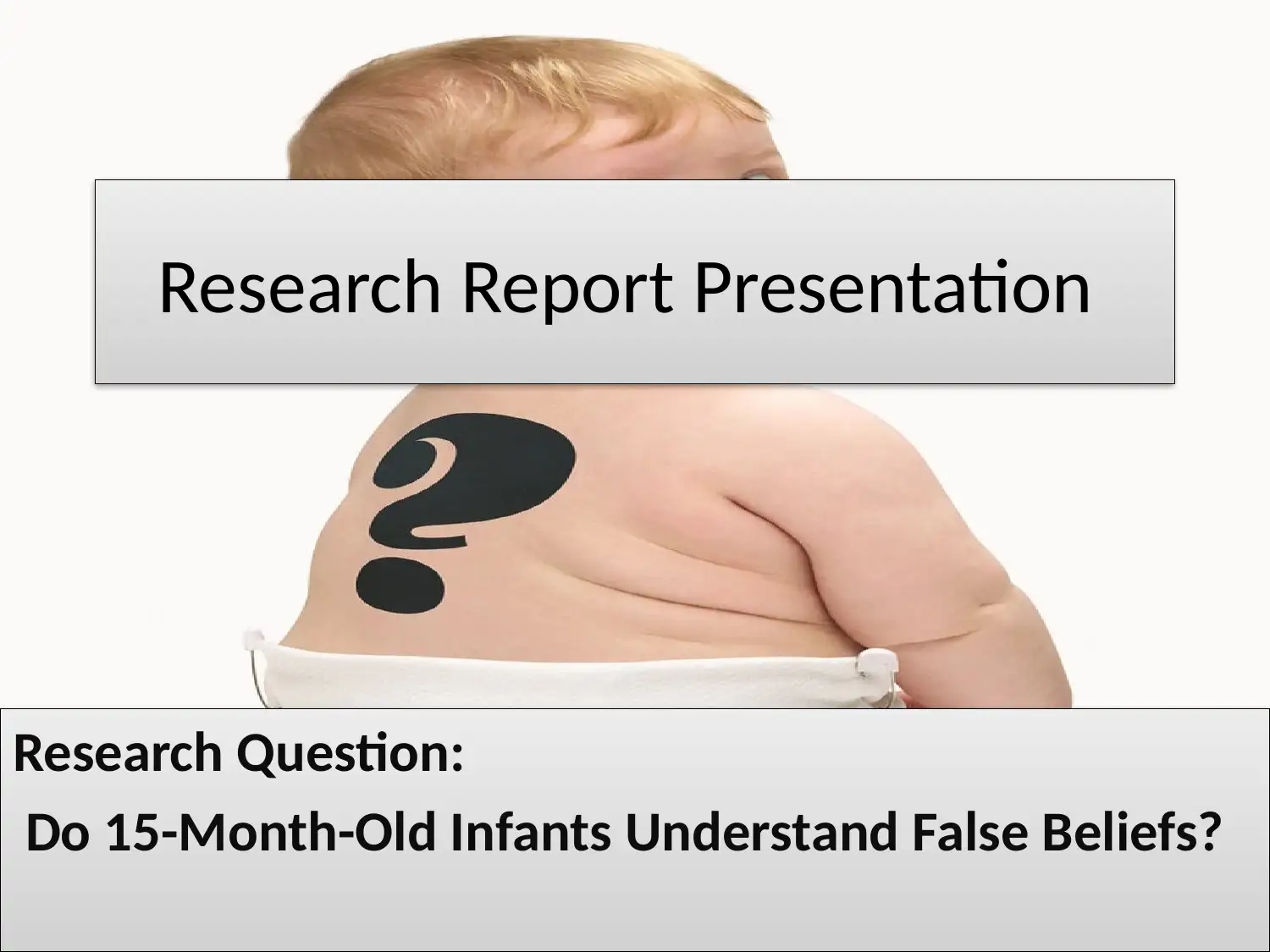
Research Report Presentation
Research Question:
Do 15-Month-Old Infants Understand False Beliefs?
Research Question:
Do 15-Month-Old Infants Understand False Beliefs?
Paraphrase This Document
Need a fresh take? Get an instant paraphrase of this document with our AI Paraphraser
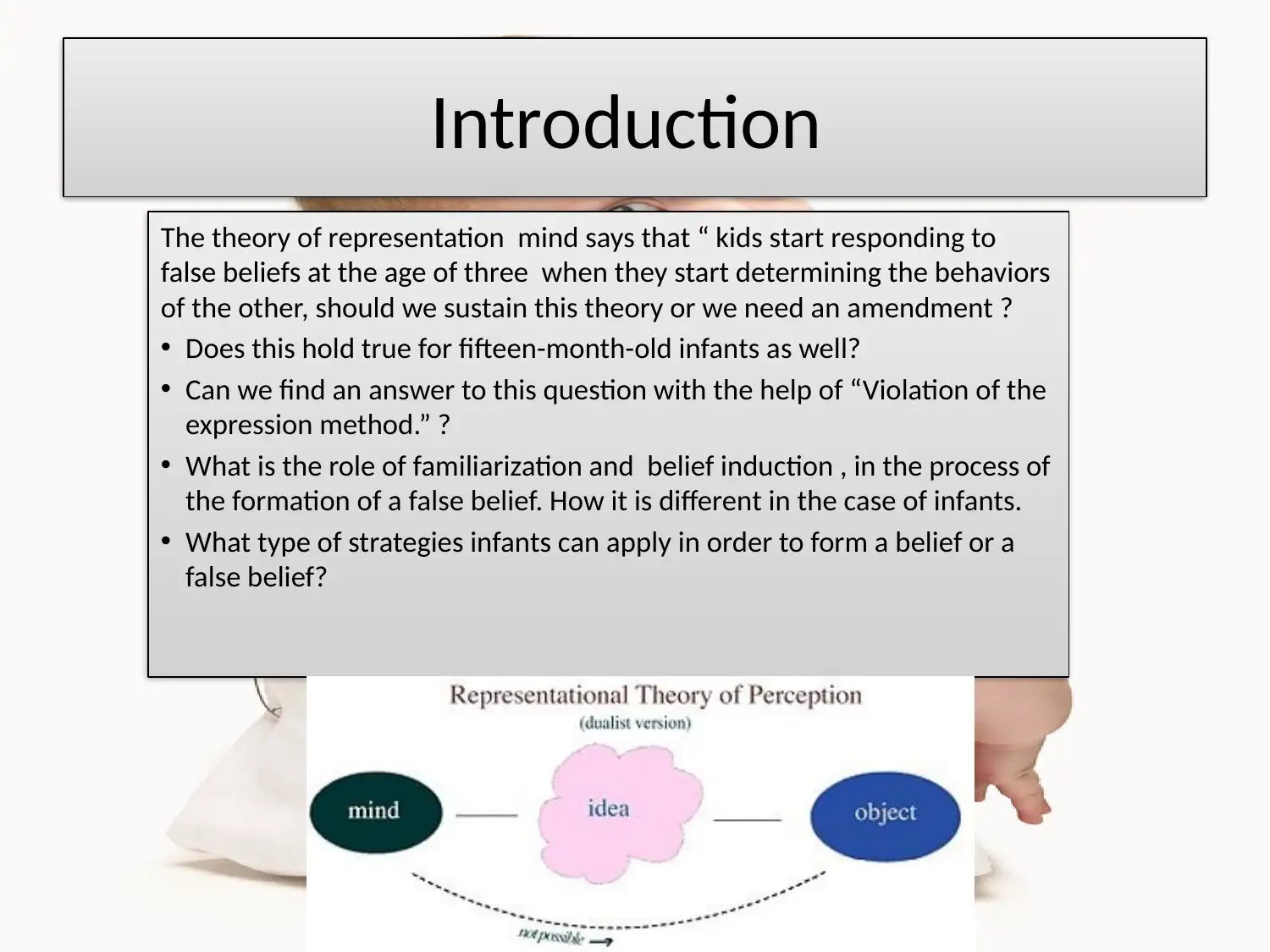
Introduction
The theory of representation mind says that “ kids start responding to
false beliefs at the age of three when they start determining the behaviors
of the other, should we sustain this theory or we need an amendment ?
• Does this hold true for fifteen-month-old infants as well?
• Can we find an answer to this question with the help of “Violation of the
expression method.” ?
• What is the role of familiarization and belief induction , in the process of
the formation of a false belief. How it is different in the case of infants.
• What type of strategies infants can apply in order to form a belief or a
false belief?
The theory of representation mind says that “ kids start responding to
false beliefs at the age of three when they start determining the behaviors
of the other, should we sustain this theory or we need an amendment ?
• Does this hold true for fifteen-month-old infants as well?
• Can we find an answer to this question with the help of “Violation of the
expression method.” ?
• What is the role of familiarization and belief induction , in the process of
the formation of a false belief. How it is different in the case of infants.
• What type of strategies infants can apply in order to form a belief or a
false belief?
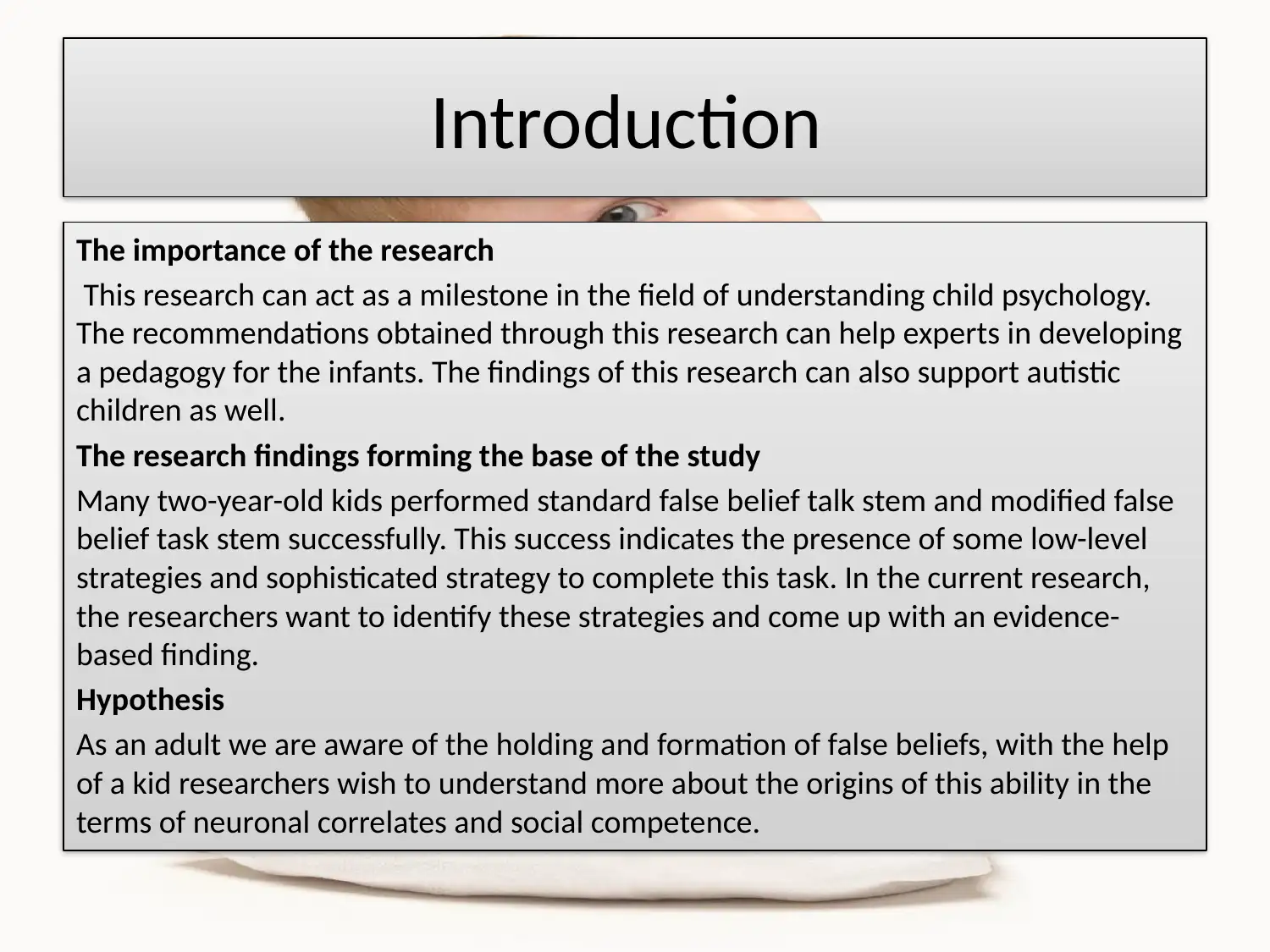
Introduction
The importance of the research
This research can act as a milestone in the field of understanding child psychology.
The recommendations obtained through this research can help experts in developing
a pedagogy for the infants. The findings of this research can also support autistic
children as well.
The research findings forming the base of the study
Many two-year-old kids performed standard false belief talk stem and modified false
belief task stem successfully. This success indicates the presence of some low-level
strategies and sophisticated strategy to complete this task. In the current research,
the researchers want to identify these strategies and come up with an evidence-
based finding.
Hypothesis
As an adult we are aware of the holding and formation of false beliefs, with the help
of a kid researchers wish to understand more about the origins of this ability in the
terms of neuronal correlates and social competence.
The importance of the research
This research can act as a milestone in the field of understanding child psychology.
The recommendations obtained through this research can help experts in developing
a pedagogy for the infants. The findings of this research can also support autistic
children as well.
The research findings forming the base of the study
Many two-year-old kids performed standard false belief talk stem and modified false
belief task stem successfully. This success indicates the presence of some low-level
strategies and sophisticated strategy to complete this task. In the current research,
the researchers want to identify these strategies and come up with an evidence-
based finding.
Hypothesis
As an adult we are aware of the holding and formation of false beliefs, with the help
of a kid researchers wish to understand more about the origins of this ability in the
terms of neuronal correlates and social competence.
⊘ This is a preview!⊘
Do you want full access?
Subscribe today to unlock all pages.

Trusted by 1+ million students worldwide
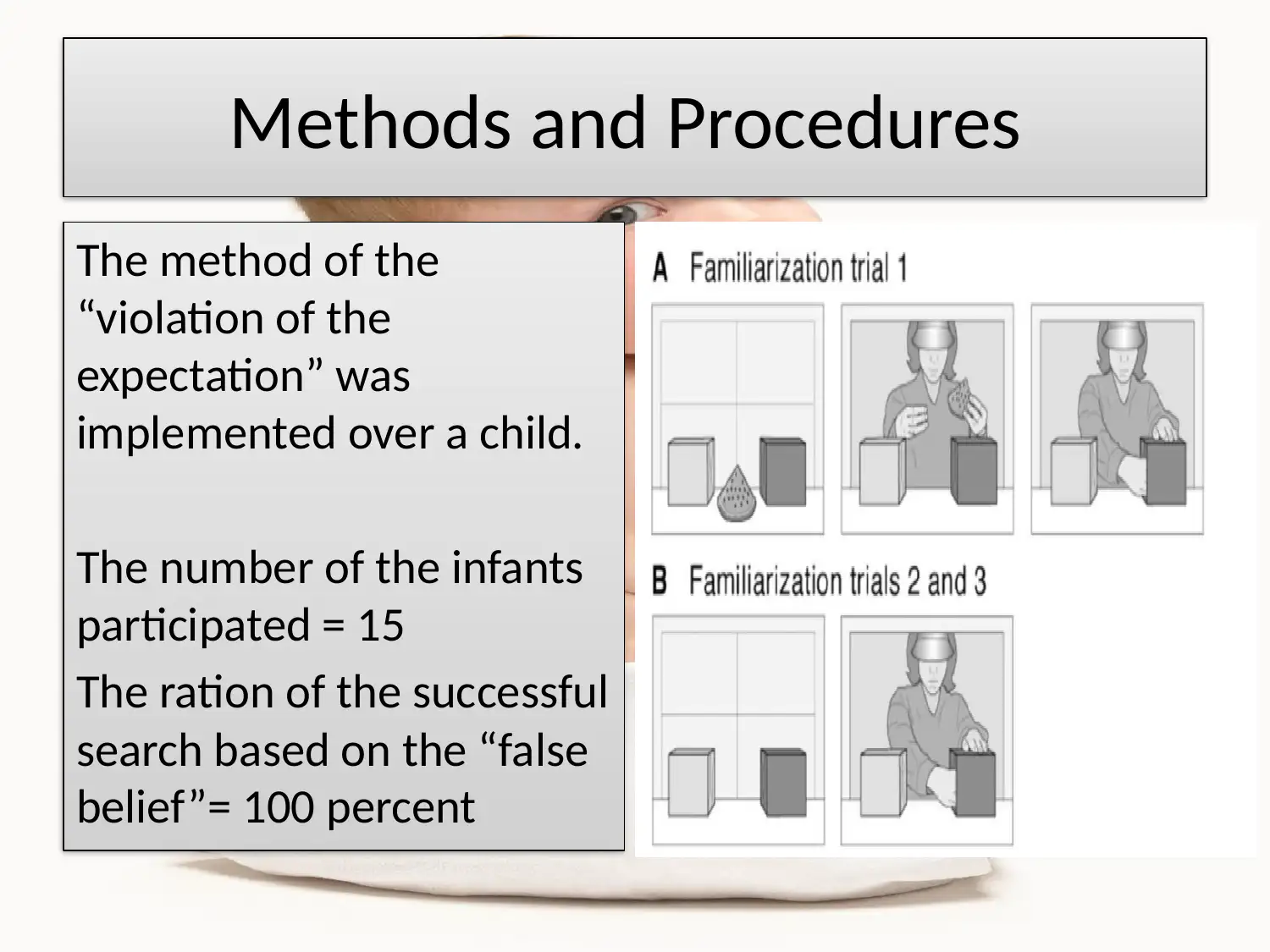
Methods and Procedures
The method of the
“violation of the
expectation” was
implemented over a child.
The number of the infants
participated = 15
The ration of the successful
search based on the “false
belief”= 100 percent
The method of the
“violation of the
expectation” was
implemented over a child.
The number of the infants
participated = 15
The ration of the successful
search based on the “false
belief”= 100 percent
Paraphrase This Document
Need a fresh take? Get an instant paraphrase of this document with our AI Paraphraser
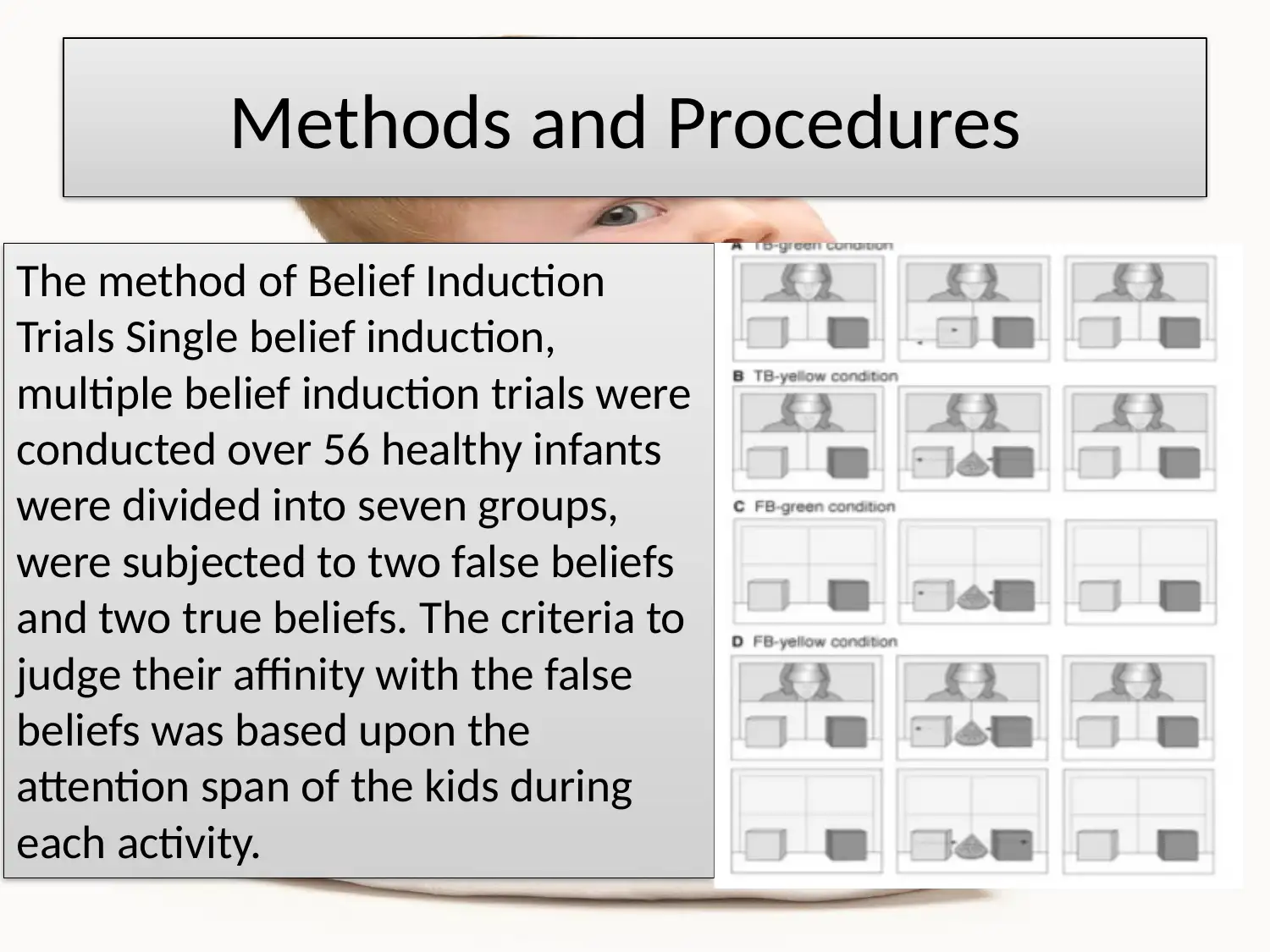
Methods and Procedures
The method of Belief Induction
Trials Single belief induction,
multiple belief induction trials were
conducted over 56 healthy infants
were divided into seven groups,
were subjected to two false beliefs
and two true beliefs. The criteria to
judge their affinity with the false
beliefs was based upon the
attention span of the kids during
each activity.
The method of Belief Induction
Trials Single belief induction,
multiple belief induction trials were
conducted over 56 healthy infants
were divided into seven groups,
were subjected to two false beliefs
and two true beliefs. The criteria to
judge their affinity with the false
beliefs was based upon the
attention span of the kids during
each activity.
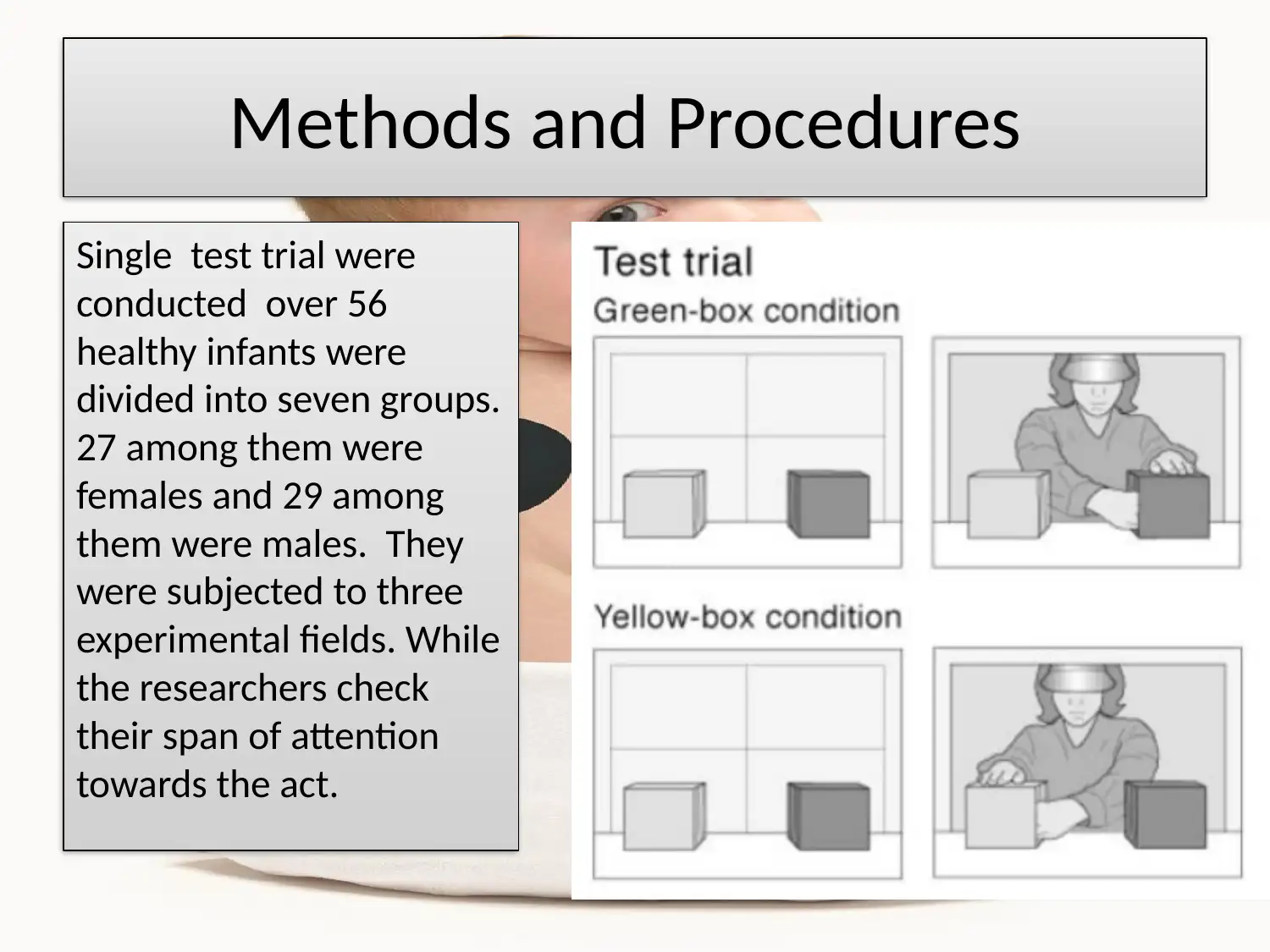
Methods and Procedures
Single test trial were
conducted over 56
healthy infants were
divided into seven groups.
27 among them were
females and 29 among
them were males. They
were subjected to three
experimental fields. While
the researchers check
their span of attention
towards the act.
Single test trial were
conducted over 56
healthy infants were
divided into seven groups.
27 among them were
females and 29 among
them were males. They
were subjected to three
experimental fields. While
the researchers check
their span of attention
towards the act.
⊘ This is a preview!⊘
Do you want full access?
Subscribe today to unlock all pages.

Trusted by 1+ million students worldwide
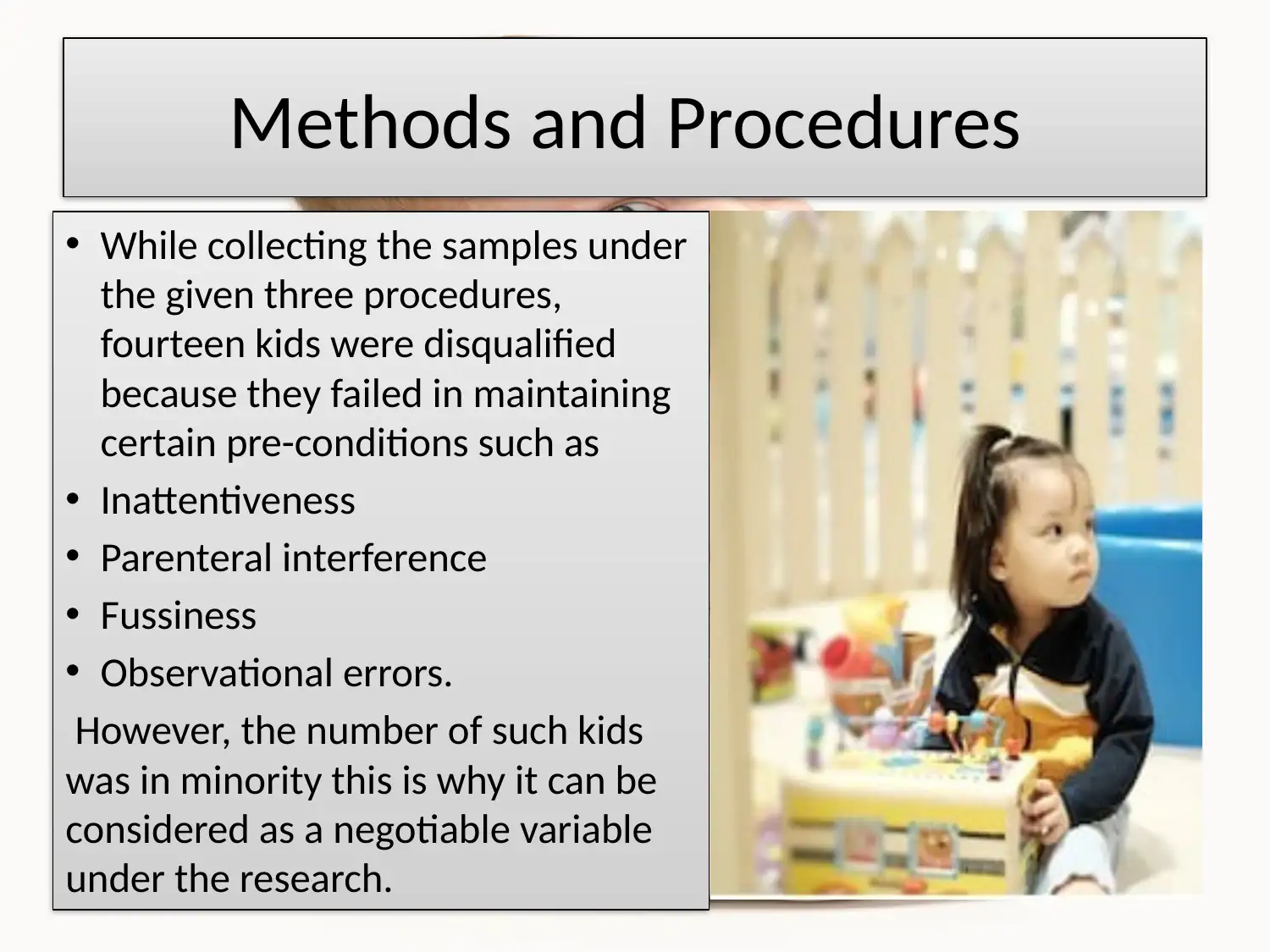
Methods and Procedures
• While collecting the samples under
the given three procedures,
fourteen kids were disqualified
because they failed in maintaining
certain pre-conditions such as
• Inattentiveness
• Parenteral interference
• Fussiness
• Observational errors.
However, the number of such kids
was in minority this is why it can be
considered as a negotiable variable
under the research.
• While collecting the samples under
the given three procedures,
fourteen kids were disqualified
because they failed in maintaining
certain pre-conditions such as
• Inattentiveness
• Parenteral interference
• Fussiness
• Observational errors.
However, the number of such kids
was in minority this is why it can be
considered as a negotiable variable
under the research.
Paraphrase This Document
Need a fresh take? Get an instant paraphrase of this document with our AI Paraphraser
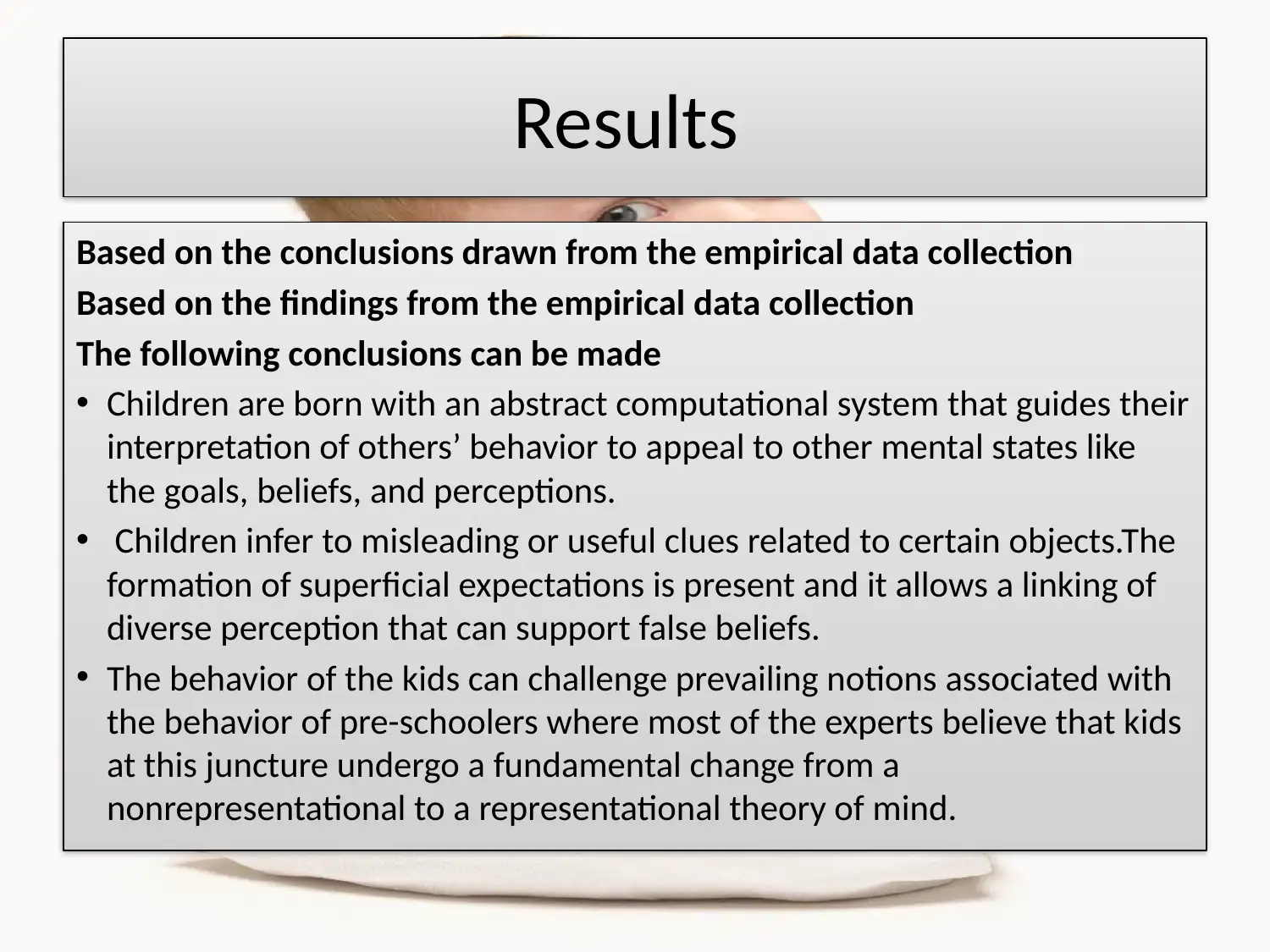
Results
Based on the conclusions drawn from the empirical data collection
Based on the findings from the empirical data collection
The following conclusions can be made
• Children are born with an abstract computational system that guides their
interpretation of others’ behavior to appeal to other mental states like
the goals, beliefs, and perceptions.
• Children infer to misleading or useful clues related to certain objects.The
formation of superficial expectations is present and it allows a linking of
diverse perception that can support false beliefs.
• The behavior of the kids can challenge prevailing notions associated with
the behavior of pre-schoolers where most of the experts believe that kids
at this juncture undergo a fundamental change from a
nonrepresentational to a representational theory of mind.
Based on the conclusions drawn from the empirical data collection
Based on the findings from the empirical data collection
The following conclusions can be made
• Children are born with an abstract computational system that guides their
interpretation of others’ behavior to appeal to other mental states like
the goals, beliefs, and perceptions.
• Children infer to misleading or useful clues related to certain objects.The
formation of superficial expectations is present and it allows a linking of
diverse perception that can support false beliefs.
• The behavior of the kids can challenge prevailing notions associated with
the behavior of pre-schoolers where most of the experts believe that kids
at this juncture undergo a fundamental change from a
nonrepresentational to a representational theory of mind.
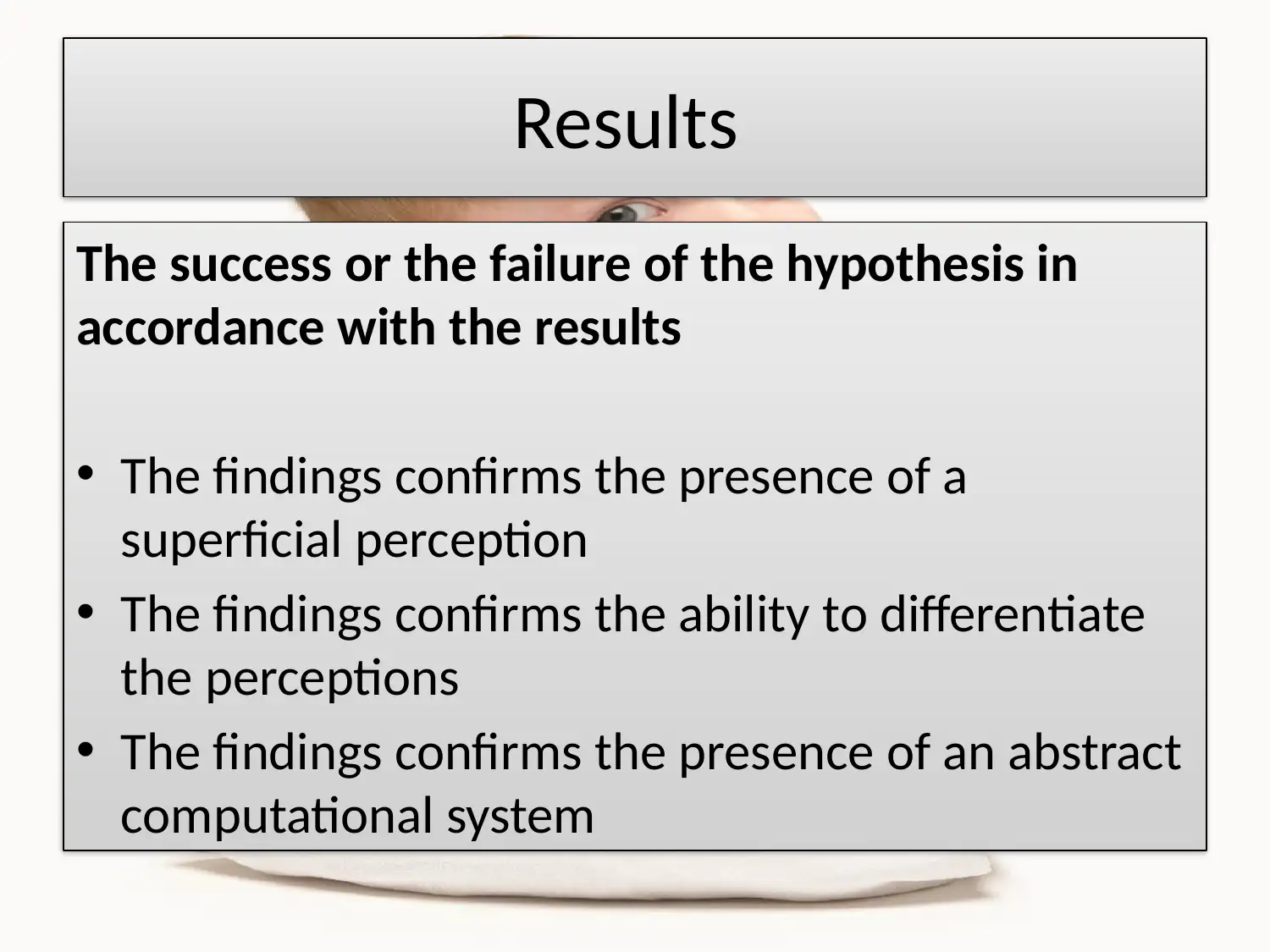
Results
The success or the failure of the hypothesis in
accordance with the results
• The findings confirms the presence of a
superficial perception
• The findings confirms the ability to differentiate
the perceptions
• The findings confirms the presence of an abstract
computational system
The success or the failure of the hypothesis in
accordance with the results
• The findings confirms the presence of a
superficial perception
• The findings confirms the ability to differentiate
the perceptions
• The findings confirms the presence of an abstract
computational system
⊘ This is a preview!⊘
Do you want full access?
Subscribe today to unlock all pages.

Trusted by 1+ million students worldwide
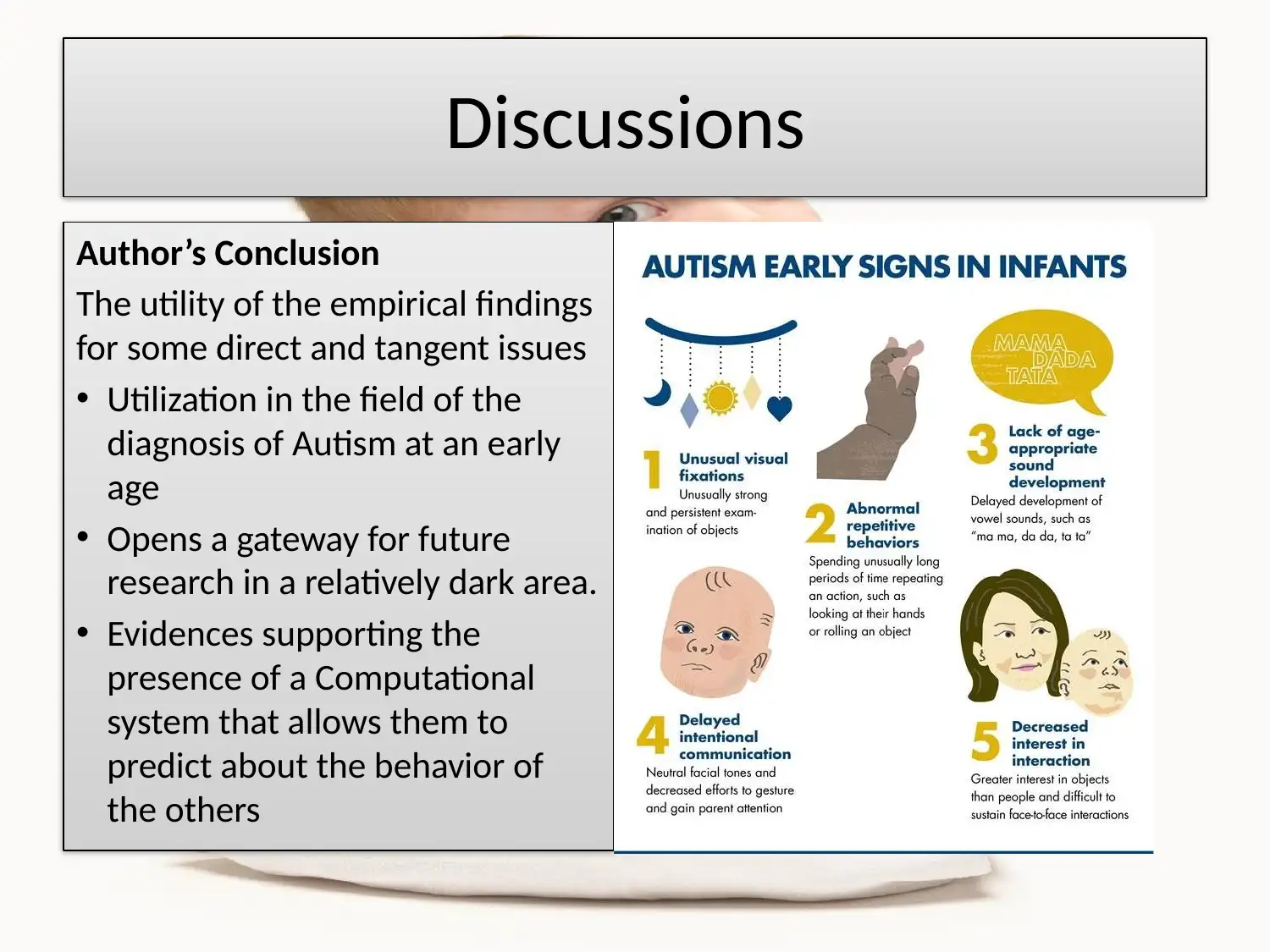
Discussions
Author’s Conclusion
The utility of the empirical findings
for some direct and tangent issues
• Utilization in the field of the
diagnosis of Autism at an early
age
• Opens a gateway for future
research in a relatively dark area.
• Evidences supporting the
presence of a Computational
system that allows them to
predict about the behavior of
the others
Author’s Conclusion
The utility of the empirical findings
for some direct and tangent issues
• Utilization in the field of the
diagnosis of Autism at an early
age
• Opens a gateway for future
research in a relatively dark area.
• Evidences supporting the
presence of a Computational
system that allows them to
predict about the behavior of
the others
Paraphrase This Document
Need a fresh take? Get an instant paraphrase of this document with our AI Paraphraser
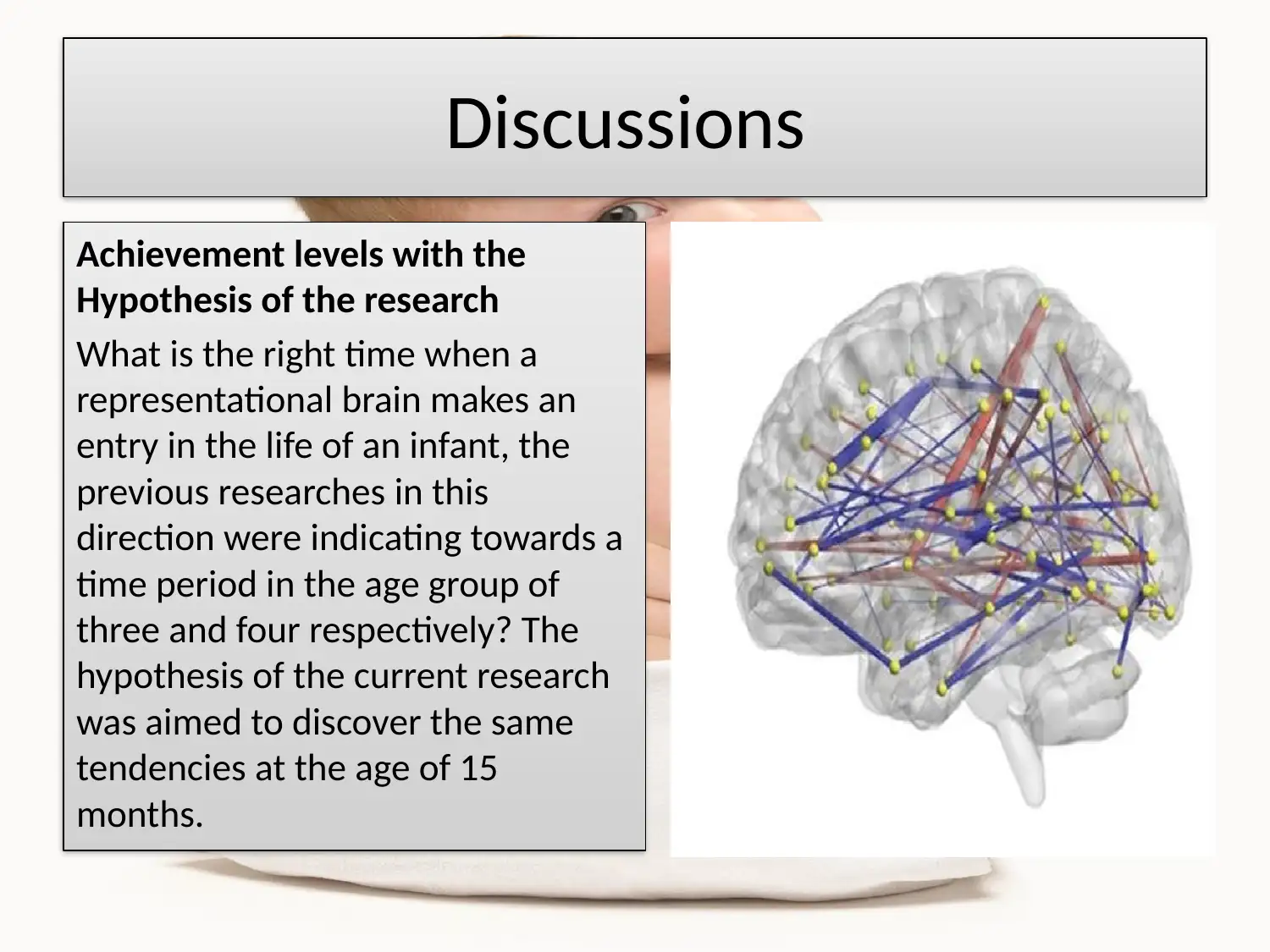
Discussions
Achievement levels with the
Hypothesis of the research
What is the right time when a
representational brain makes an
entry in the life of an infant, the
previous researches in this
direction were indicating towards a
time period in the age group of
three and four respectively? The
hypothesis of the current research
was aimed to discover the same
tendencies at the age of 15
months.
Achievement levels with the
Hypothesis of the research
What is the right time when a
representational brain makes an
entry in the life of an infant, the
previous researches in this
direction were indicating towards a
time period in the age group of
three and four respectively? The
hypothesis of the current research
was aimed to discover the same
tendencies at the age of 15
months.
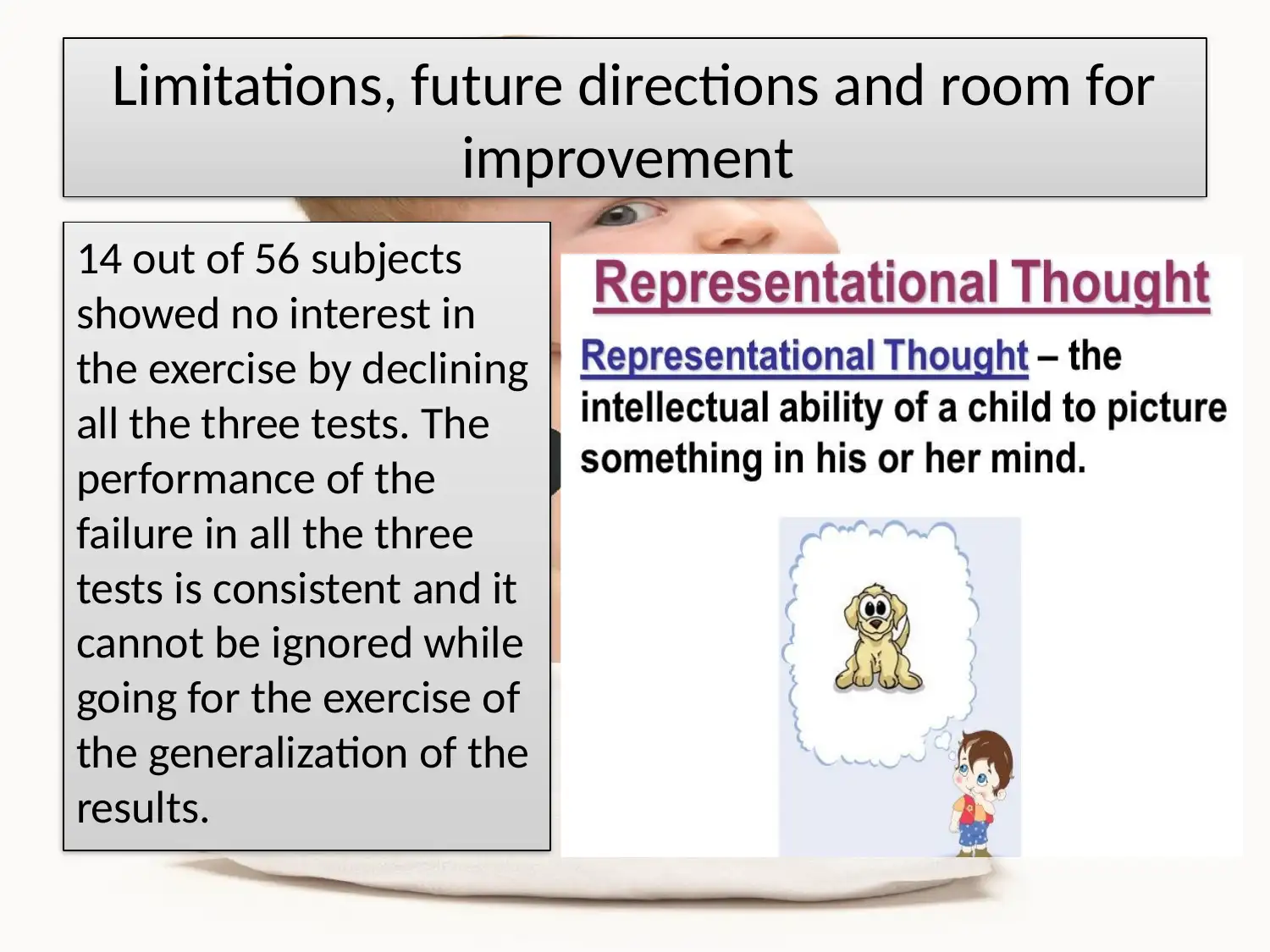
Limitations, future directions and room for
improvement
14 out of 56 subjects
showed no interest in
the exercise by declining
all the three tests. The
performance of the
failure in all the three
tests is consistent and it
cannot be ignored while
going for the exercise of
the generalization of the
results.
improvement
14 out of 56 subjects
showed no interest in
the exercise by declining
all the three tests. The
performance of the
failure in all the three
tests is consistent and it
cannot be ignored while
going for the exercise of
the generalization of the
results.
⊘ This is a preview!⊘
Do you want full access?
Subscribe today to unlock all pages.

Trusted by 1+ million students worldwide
1 out of 19
Your All-in-One AI-Powered Toolkit for Academic Success.
+13062052269
info@desklib.com
Available 24*7 on WhatsApp / Email
![[object Object]](/_next/static/media/star-bottom.7253800d.svg)
Unlock your academic potential
Copyright © 2020–2025 A2Z Services. All Rights Reserved. Developed and managed by ZUCOL.